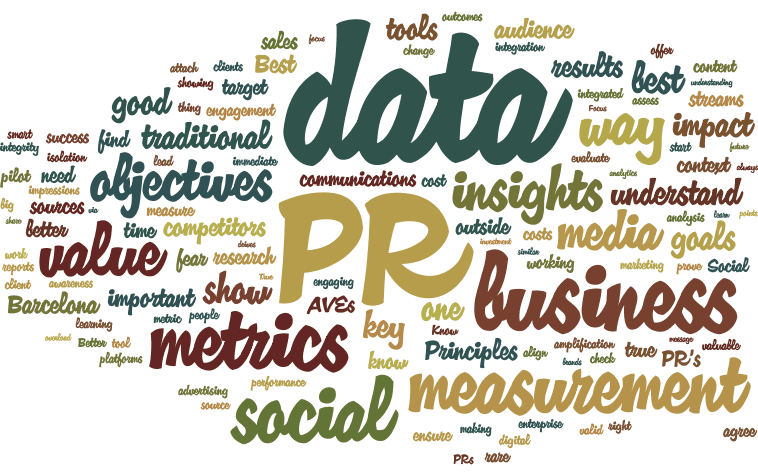Last week one of our Trustees and three members of the Measurement commission, participated in the PR News Measurement Hall of Fame Twitter Chat in celebration of AMEC’s Measurement Month. Linda Rutherford, VP for communications and outreach at Southwest Airlines joined Mark Weiner, CEO of PRIME Research, Allyson Hugley, president of Measurement, Analytics and Insights at Weber Shandwick to spend an hour answering Steve Goldstein’s quick fire questions providing tips around various aspects of measurement.
With more than twenty questions covered in the hour, here are some of the highlights.
 What’s your #1 tip for creating measurable, realistic goals for PR campaigns?
What’s your #1 tip for creating measurable, realistic goals for PR campaigns?
There was broad agreement that when creating measureable, realistic goals for PR campaigns it is important to understand the objectives and tie them back to the organization. The objectives should be SMART (Specific, Measureable, Attainable, Realistic and Time Based) and should reflect the available resources such as time, talent and level of investment.
How do you decide which communications data to pull when you’re swimming in data?
Data is a commodity and you wish to avoid overload. Thus the focus is on the data that matters most, prioritize the data that supports the business goals, which will add value when tying back to the Key Performance Indicators (KPIs). The key is the insights derived from the data through data analytics, critical thinking and subject expertise. And a word of warning; don’t assume all data is good data.
What’s the most important question to ask someone who’s trying to sell you measurement technology?
Here are the top three tips to consider:
- Data validity – how is it collected, what is and is not there?
- Transparency – don’t be afraid to ask for methodology details or be fooled by proprietary algorithms
- Test how intuitive the platform is and ask for a pilot
What’s the next thing in measuring media coverage?
Integration was a common theme – integrating coverage metrics into larger work streams, integrating traditional and social, integration with other business data such as sales and performance. Most answers looked beyond communications with a focus on insights and business results. This led to a question on PR measurement and business outcomes being incorporated into a single report. These reports hold greater value and are much more insightful. The key to data integration for PR is to include other data streams before making assumptions on PR’s business impact. In most cases other data needs to be factored in to “prove” the PR impact to the organization.
How can you tell if the right people are engaging with you on social media?
A good starting point is to determine the target audience and start listening. PR managers should include target audience profiles in their social media objectives aids focus. Research can play a role here to evaluate conversation content, assess profiles of those engaged and conduct an influencer study. Through primary research on the people who are engaging with the content on social, you can drill deeper into brand perceptions and purchase intent, test messaging and more. To expand the base, be open to emerging influencers. The “right people” for engagement often come from counterintuitive and unexpected places so be open-minded. Also, recognize that influencers change over time.
How do you put a dollar value on social media?
The metrics vary based on goals; ranging from web traffic to sales to increased Customer Satisfaction to cost savings. The sexy way to attach a dollar is to quantify PR’s contribution to sales. This is hard to do and can be expensive. Stepping outside of the social data you can introduce survey research to evaluate differences in purchase intent and spend among social followers. Following on from this we discussed the value of social and traditional media, recognizing that neither can be ignored and it is important to understand the relationship between them. Traditional media is now more social with coverage tweeted, journalists’ blogging and engaging with readers on social platforms.
How do you go beyond impressions to provide proof of a successful PR program?
Most executives know that impressions don’t mean much. Given the choice, they prefer quality of messaging, awareness, attitudes, etc. Impressions are a vanity metric, but they are also an input for Market Mix Modeling so they can’t be discounted completely. A further way of relooking at a “noise” metric is with social amplification.
What inside tips can you share about reporting results to senior management?
- Speak the language of senior management – don’t expect them to translate
- Know their priorities and their preferences for data-driven reports
- Stay focused on key performance indicators
- Avoid data overload or data dumps
- Less is more and context is crucial
- Where possible, show correlation/support for business’ bottom line.
My thanks to Steve, Linda, Mark and Allyson for the various tweets and retweets that, along with mine, have contributed to this post.
Pauline Draper-Watts is Executive Vice President of Edelman Berland, leading their measurement and analytics globally, and a member of the IPR Measurement Commission. Follow her on Twitter @PDWatts.




Thank you, Pauline. The cause of public relations research and evaluation was well-served by the panel, the moderator and our audience. A lot of the tweets continue to circulate on Twitter at #prmeasure. if one seeks to learn more.